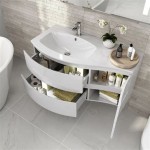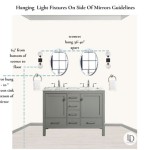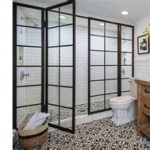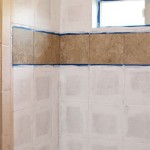Understanding Bathroom Sink Drain Extensions
The bathroom sink drain extension is a crucial component of the plumbing system responsible for efficiently and safely removing wastewater from the sink. This seemingly simple piece of hardware plays a vital role in preventing leaks, maintaining proper drainage, and ensuring the overall functionality of the bathroom. A well-installed and properly functioning drain extension contributes significantly to the hygiene and maintenance of the bathroom environment. Its importance is often overlooked until problems arise, such as slow drainage, unpleasant odors, or, more seriously, water damage due to leakage.
This article aims to provide a comprehensive understanding of bathroom sink drain extensions, covering their purpose, types, installation considerations, common problems, and maintenance tips. By gaining a thorough understanding of these aspects, homeowners and professionals alike can effectively address issues related to drain extensions and ensure the long-term performance of the bathroom sink plumbing system.
Purpose and Function of a Bathroom Sink Drain Extension
The primary purpose of a bathroom sink drain extension is to bridge the gap between the sink drain outlet and the P-trap. The P-trap is a curved pipe designed to hold a small amount of water, which acts as a barrier preventing sewer gases from entering the bathroom through the drain. The extension allows for flexibility in connecting these two components, particularly when the distance or alignment between them is not ideal. This is a frequent scenario in plumbing installations due to variations in sink designs, cabinet configurations, and existing plumbing layouts.
Beyond its basic connecting function, the drain extension contributes to the overall drainage efficiency of the sink. A smooth, unobstructed extension allows water to flow freely, preventing the buildup of debris and reducing the likelihood of clogs. Furthermore, the extension plays a crucial role in maintaining a watertight seal, preventing water leakage that can lead to structural damage and mold growth. The integrity of this seal is paramount in preventing water damage to the vanity cabinet and surrounding floor.
The material and construction of the drain extension also influence its performance. Durable materials, such as brass or PVC, are resistant to corrosion and degradation, ensuring a longer lifespan. Proper installation techniques, including tightening connections and using appropriate sealant, are essential for maintaining a leak-free system. A correctly installed drain extension therefore directly impacts the longevity and reliability of the entire sink plumbing system.
Types of Bathroom Sink Drain Extensions
Bathroom sink drain extensions are available in various materials, lengths, and configurations to accommodate different plumbing setups. Selecting the appropriate type is critical for ensuring a proper fit and optimal performance. Common materials include PVC, polypropylene, brass, and stainless steel. Each material offers different characteristics in terms of durability, corrosion resistance, and cost.
PVC (polyvinyl chloride) is a popular choice due to its affordability, ease of installation, and resistance to corrosion. It is lightweight and can be easily cut to the desired length. However, PVC may not be as durable as metal options and can become brittle over time, especially in environments with fluctuating temperatures. Polypropylene is another plastic option, offering similar benefits to PVC but with slightly improved heat resistance. It is also a cost-effective option for many installations.
Brass drain extensions offer superior durability and corrosion resistance compared to plastic options. Brass is a heavier, more robust material that can withstand higher water pressure and temperature variations. While more expensive than PVC or polypropylene, brass extensions are a long-lasting solution that can provide years of reliable service. Stainless steel is another durable and corrosion-resistant option, offering a sleek and modern aesthetic. Stainless steel extensions are often preferred in high-end bathroom renovations.
In addition to material variations, drain extensions are available in different lengths and configurations. Straight extensions are the most common type, used to connect the sink drain directly to the P-trap. Adjustable extensions allow for fine-tuning the length to accommodate specific plumbing configurations. These adjustable extensions typically feature a telescoping design, allowing for a range of length adjustments.
Flexible drain extensions are designed to bend and conform to tight spaces or unusual angles. These extensions are often made of corrugated plastic or rubber and can be useful in situations where a rigid extension would be difficult to install. However, flexible extensions are more prone to clogging and may not be as durable as rigid options. Choosing the correct type of drain extension depends on a variety of factors, including the distance between the sink drain and the P-trap, the available space, the desired level of durability, and the overall aesthetic of the bathroom.
Installation Considerations and Common Problems
Proper installation of a bathroom sink drain extension is essential for preventing leaks and ensuring efficient drainage. Incorrect installation is a common cause of plumbing problems, leading to water damage and costly repairs. Before beginning the installation process, it is important to gather the necessary tools and materials, including a pipe wrench, adjustable pliers, Teflon tape, and a bucket to catch any water drips.
The first step is to measure the distance between the sink drain outlet and the P-trap. This measurement will determine the length of the drain extension needed. It is important to select an extension that is slightly longer than the measured distance, as it is always easier to cut a pipe shorter than to extend it. When cutting the drain extension, use a fine-tooth saw or a pipe cutter to ensure a clean, straight cut. A jagged or uneven cut can create leaks.
Before connecting the drain extension, apply Teflon tape to the threads of the drain outlet and the P-trap. Teflon tape creates a watertight seal and prevents leaks. Wrap the tape clockwise around the threads, overlapping each layer slightly. Once the tape is applied, carefully connect the drain extension to the drain outlet and the P-trap. Tighten the connections using a pipe wrench or adjustable pliers, but be careful not to overtighten, as this can damage the pipes or fittings. A firm, snug fit is sufficient to create a seal.
After the drain extension is installed, it is important to test for leaks. Turn on the water and allow it to run for several minutes, checking all connections for any signs of dripping. If leaks are detected, tighten the connections further or reapply Teflon tape. If the leaks persist, there may be a problem with the pipes or fittings themselves, requiring further inspection or replacement. Common problems associated with bathroom sink drain extensions include leaks at the connections, clogs within the extension, and corrosion or damage to the extension material.
Leaks at the connections are often caused by improper installation, loose fittings, or worn-out Teflon tape. Clogs can occur due to the accumulation of hair, soap scum, and other debris within the drain extension. Regular cleaning of the drain extension can help prevent clogs. Corrosion or damage to the extension material can be caused by exposure to harsh chemicals or abrasive cleaners. Using mild, non-abrasive cleaners can help extend the life of the drain extension. In cases of severe corrosion or damage, the drain extension will need to be replaced.
Maintenance and Prevention of Problems
Regular maintenance is crucial for prolonging the life of a bathroom sink drain extension and preventing common problems such as clogs and leaks. Simple preventative measures can save time and money in the long run by avoiding costly repairs or replacements. One of the most effective maintenance techniques is to regularly flush the drain with hot water. This helps to dissolve grease and soap buildup, preventing clogs from forming.
Another important maintenance step is to clean the drain stopper frequently. The drain stopper is often a collection point for hair, soap scum, and other debris, which can contribute to clogs. Removing the stopper and cleaning it thoroughly with a brush and mild detergent can help maintain proper drainage. Avoid using harsh chemical drain cleaners, as these can damage the drain extension material and corrode the pipes. Enzymatic drain cleaners are a safer and more environmentally friendly alternative.
Visually inspect the drain extension regularly for any signs of leaks or corrosion. Check the connections between the drain extension, the sink drain outlet, and the P-trap. If any leaks are detected, tighten the connections or reapply Teflon tape. If the corrosion is present, consider replacing the drain extension with a more durable material, such as brass or stainless steel. It is also important to avoid pouring harsh chemicals down the drain, as these can damage the drain extension and other plumbing components. Dispose of chemicals properly according to the manufacturer's instructions.
In addition to these preventative measures, it is important to be mindful of what goes down the drain. Avoid flushing large quantities of hair, grease, or food particles, as these can contribute to clogs. Use a drain strainer to catch hair and other debris before they enter the drain. By following these maintenance tips and practicing good plumbing habits, it is possible to extend the life of a bathroom sink drain extension and prevent common problems.

Water Drain Hose Pipe Home Universal Bathroom Basin Strainer Extension Gray Washbowl Free Lazada Singapore

Oatey Form N Fit 1 2 In X 11 4 White Plastic Slip Joint Sink Drain Tailpiece Extension Tube Hdc3526955 The Home Depot

How To Install A Flexible Waste Pipe When The Drain Doesn T Line Up Handyman S Daughter

Oatey 1 2 In X 12 White Plastic Solvent Weld Sink Drain Tailpiece Extension Tube C9787a The Home Depot

Sufanic Flexible And Expandable Drain Pipe Tube S Trap Universal Plastic Angle Simple Extension For Kitchen Bathroom Sink Sewer Wash Basin Com

Insta Plumb Sink Extension Tube 12 X 1 2 40 12qlk Rona

Bathroom Sink Drain Pipe Extension Expandable Wash Basin Hose Tube Tailpiece For Overflow Vessel Com

58mm Kitchen Bathroom Sink Drain Extension Pipe Deodorant Sewer Tube

How To Install A Pipe From Sink Drain Wall Ehow

Pop Up Sink Drain Repair Stopper Pivot Rod Bathroom
Related Posts







